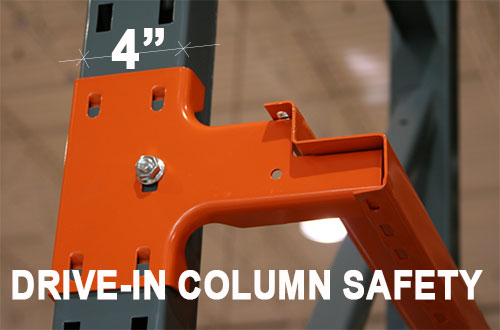The Drive-in rack configuration is unique because the fork-lift actually enters into the storage bay. For this reason, there cannot be a cross-bay beam except at the very top of the bay at the rear-most storage position which is beyond the travel depth of the truck. In the case of a double entry drive-in, where the truck enters from both sides and travels toward the middle, these cross-bay (anchor) beams may be in the middle area of the bay. For the columns without cross-bay beams, the load rails are supported by load arms that attach to the tall slender column.
Drive-in can be a very sound and reliable rack structure when the column is adequately stiff, but can be problematic or even dangerous when the column stiffness is not sufficient. The obvious problem that can occur when the column stiffness is inadequate is side-sway collapse. The less obvious problem is that for very tall slender column, the slightest lateral bump at mid-height can cause the column to deflect outward and the distance between the guide rails to increase, allowing pallets to drop from the rails. this occurs because there is typically only about 1” of bite figured for a pallet that is side-shifted to one side between the guide rails. This problem can occur when a designer is tempted to use a slender column that “checks” because the customer’s pallet weights are not heavy, but the designer has not considered the problems mentioned above. This may not be as much of an issue when the load weights are heavier because the slender column may not even “check” for the heavier load scenarios.
The specifications have traditionally discouraged the use of compression members whose slenderness ratios (KL/R values) exceed 200 for these types of reasons. For a drive-in rack with a 3” column this ratio is exceeded for a symmetrically loaded drive-in column height in the 22’ to 23’ range. At this height, the design should go to a 4” column. Similarly, at about 31’to 32’, the column design should go to 5”. These are not absolute numbers, but vary depending on the center of gravity elevations of the applied loads and a number of other factors.
It is also generally more economical to choose a column that is not so slender. For example, a 4” column may be a better and cheaper choice than trying to double a 3” column for a drive-in application because the stiffness (moment of inertia of the section) for a 4” column may be higher than the doubled 3” column and weigh less. For example, a C3 x 3.5 structural channel column doubled is 7# per foot and has a moment of inertia of 3.14 in^4. The single C4x4.5 column weighs only 4.5# per foot and has a moment of inertia of 3.53 in^4. The moment of inertia property is a measure of the section’s ability to resist deflection (or a measure of stiffness). From both a cost and a stiffness standpoint, the 4” column becomes the better choice.
Finally, aesthetics should also be a concern because a slender looking column can make those charged with working in and around the racks uncomfortable or unsafe.
